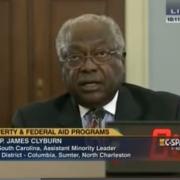WASHINGTON — Today, Assistant Democratic Leader James E. Clyburn testified on the Congressional Black Caucus (CBC) 10-20-30 anti-poverty plan at the House Committee on the Budget hearing titled “A Progress Report on the War on Poverty: Reforming Federal Aid.” Full video of Mr. Clyburn’s testimony (click image to view) and text of remarks as prepared for delivery are below:
“Mr. Chairman, Ranking Member Van Hollen, members of the committee—good morning. Thank you for having me here today to discuss the important issue of persistent poverty in America and how we can combat it through the 10-20-30 initiative.
It is no secret that there are major disagreements among the members of this committee and our respective parties over the role that the federal government should play in fighting poverty and confronting many other national challenges. These disagreements, put simply, come down to a question of federal resources: I believe that we should target more resources to impoverished communities than your proposed budgets allocate, and I believe we can do so efficiently and effectively.
I was privileged to have the opportunity to work through some of these disagreements with some of you last year as a member of the Budget Conference Committee, and the deal that resulted, while not 100% of what either side wanted, was a reasonable compromise on federal spending through the end of the next fiscal year that I was proud to support.
Now that we have determined how much the federal government will spend, we must determine how to spend it most effectively. It is on this latter question—how to allocate finite federal resources to get the most “bang for the buck”—that I believe we may be able to find more common ground to make real strides in combating persistent poverty in America.
Mr. Chairman, there are currently 488 persistent poverty counties in America—so defined because 20 percent of the population has lived below the poverty line for the past 30 years or more. They are diverse, including Appalachian communities in states like Kentucky and West Virginia, Native American communities in states like Alaska and South Dakota, Latino communities in states like Arizona and Texas, African American communities in states like South Carolina, Mississippi, and Alabama. They are urban communities in the Northeast, and rural in America’s heartland. 139 of these counties are represented in this august body by Democrats, 331 by Republicans, and 18 are split between the two parties. Combating persistent poverty should matter to all of us, regardless of party, geography, or race.
In early 2009, when we were putting together the Recovery Act, I proposed language to require at least 10 percent of funds in the rural development account to be directed to projects in these persistent poverty counties. This requirement was enacted into law. In light of the definition of persistent poverty counties as having at least 20-percent poverty rates over 30 years, this provision became known as the 10-20-30 initiative.
This provision bore dividends, as economic development projects proliferated in persistent poverty counties across the country. The Recovery Act funded a total of 4,655 projects in persistent poverty counties, totaling nearly $1.7 billion. I saw firsthand the positive effects of these projects in my Congressional District. Projects were undertaken and jobs created that would have otherwise gone lacking. Among these investments was a $5.8 million grant and $2 million loan to construct 51 miles of water lines in the Britton’s Neck community in Marion County, which I represented at the time and my colleague Mr. Rice, who sits on this committee, represents today. In Lowndes County, Mississippi, $17.5 million was spent to install a water line, elevated tank, and two wastewater pump stations, providing potable water to Mississippians and creating badly needed construction jobs. The Wellborn Special Utility District in Brazos County, Texas, received a $538,000 loan to construct more than 9 miles of new water distribution lines and connect over 60 households to a new water source.
I come before the Budget Committee today to ask that, as you decide how best to allocate federal resources, you expand 10-20-30 to other federal agencies. In 2011, I joined with our former Republican colleague, then-Representative Jo Ann Emerson of Missouri, to introduce an amendment to the Continuing Resolution that would have continued 10-20-30 for rural development and expanded it to 11 additional accounts throughout the federal government affecting economic development, education, job training, health, justice, the environment, and more. I hope to work with members of this committee to include similar language in future budget resolutions and other legislation.
I want to make one thing clear about the 10-20-30 approach. It does not—I repeat, does not—add one dime to the deficit. It simply allocates resources from funds already authorized or appropriated.
Over the past 30 years, the national economy has risen and fallen multiple times. During each economic downturn, while we have been rightly focused on getting economy as a whole back on track, we have not given adequate attention to these communities that are suffering from chronic distress and Depression-era levels of joblessness. As a result, they have suffered even in good economic times. The 10-20-30 approach would provide a mechanism to address this deprivation in times of want and in times of plenty, in times of federal investment and in times of fiscal austerity.
I published an article on 10-20-30 in the most recent issue of the Harvard Journal on Legislation. I discuss the history of our nation’s efforts to address chronic poverty and more fully lay out the case for broadly implementing 10-20-30 in a bipartisan fashion. I have included the full article in my written testimony so that it appears in the record, and I encourage the members of the committee to read it when you have the opportunity. I look forward to discussing this issue further with you and to working together to eliminate the scourge of persistent poverty in these distressed communities.
Thank you for having me today.

